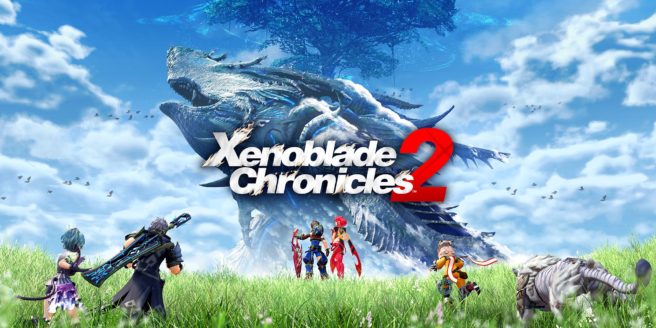Xenoblade Chronicles 2 director on development, inspiration for the world and setting, upcoming DLC, more
When asked why they made the Tiger! Tiger! mini-game to customize Poppi, Takahashi said that they don’t really have a backstory behind it; just a rough setting of transporting items that fall from the Sea of Clouds. It is considered as a modification of a legendary game that has been passed on through generations. It was originally going to be a simple game that’s accessed by just talking to Tora, but as that wouldn’t sound too interesting, Monolith Soft made a cabinet for the mini-game instead.
The fields were made very vast because, first and foremost, they want players to continually be engaged with the adventure and feel like they’re getting rewarded. If Xenoblade Chronicles X was considered a ‘mountain climbing game’, 2 would be thought of more as a ‘mountain descending game’ instead. Fields are composed not only horizontally but also vertically. By looking at all sides – not only above but also below – players can find new playthrough methods.
When asked if the Titans have a fixed or random pattern when moving in the Sea of Clouds, it turns out that they are orbiting the World Tree. As some locations also move in the fields themselves, they decided not to put directions (North/East/West/South) in the mini-map as it would cause confusion.
Takahashi notes that Titans do grow up as they age and they take energy from the Sea of Clouds. People can think of it as them eating clouds to grow up.
When asked about the concept behind the Titans, Takahashi said that it wouldn’t be interesting if characters simply just walk on the ground. While they were inspired a bit by Xenoblade 1’s giant and mechanical gods, they had another foundation for 2’s setting; and after putting more logical thoughts to it, they came up with Alrest and the Titans.
Takahashi estimates that Xenoblade Chronicles 2’s map is of about the same size as 1. However, he feels that this title has more playthrough method possibilities.
4Gamer notes that Xenoblade Chronicles 2 has so many sidequests that they’re worried players might end up getting too absorbed with them and forget about the main story. Takahashi’s team didn’t do anything to remind players of the main story, although they did put pointers for main story events. Takahashi says though that while the main story has a serious tone to it, the sidequests are more comical in nature, so he hopes players get to enjoy that gap.
Takahashi says it would be alright for players to just focus on the main story, as each Driver already has a very unique and strong Blade, and the game is balanced enough to let such players clear the game. However, he warns that there are enemies of over level 100 that can’t be defeated without the proper preparations.
There might be enemies that are even stronger than the final boss, but overall it should be easier to fight in battles because accuracy was made more lenient than Xenoblade Chronicles 1, so players can land hits on enemies with a high level difference or just raise the accuracy stat if their attacks keep missing.
Takahashi is confident that the gimmicks in the game will allows completionists to play for a very long time. Just simply beating the main game story doesn’t let you unlock everything on the Blades’ Affinity Chart. So perhaps the post-clear segment is the game’s real deal.
Xenoblade Chronicles 2’s story volume is about 1.2 – 1.3 times that of the original game. The overall volume is much higher due to exploration, sidequests, high-level monsters, and more. Takahashi himself recorded a little more than 60 hours to beat the main story with minimal customization and no sidequests at all.
Takahashi compares developing on Switch to Wii U: since Switch doesn’t use two screens, they were able to focus on the single main screen. They also made the UI to be bigger than Xenoblade Chronicles X, thus increasing interface visibility. The Joy-Con controls are also easy to work with.
When asked about what makes Switch appealing, Takahashi answers that the concept of being playable anywhere and anytime matches well with the RPG genre. For example, you can grind levels and farm items while commuting to school or work, and then enjoy event cut-scenes on a bigger screen at home. The high quality of Switch’s display also means that there is almost no difference between portable TV modes despite the resolution change.
The Expansion Pass was decided to be implemented during the middle phase of development. Monolith Soft would like players to be able to experience the world of Alrest a bit longer, so they wanted to add more content after release as well.
The scenario for the new story available next year via the Expansion Pass is already done. But due to the sheer volume of it, it’s going to take a lot of time to develop; that’s why they have a long-term schedule until Fall 2018. The new story can also be played without even completing the original story first, but it would be more enjoyable if players have finished it.
When asked on whether the team already has ideas for the additional Blades, Takahashi said that it actually takes a great deal of effort just to finish a single one. They have the following sequence when working on a Blade: designing, making the model, creating animations, putting them in quests, and recording voices.
Takahashi was also asked about the a possibility to release more paid DLC outside of the Expansion Pass. He said that if there are requests, while he’d like to think about that, the team is really getting its hands full with the Expansion Pass’ development, so he can’t really see if the team can extend to that for now.
